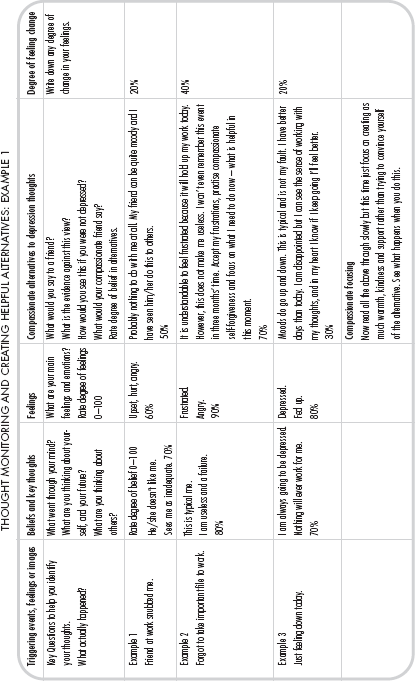
These forms and how to use them are explained in Chapter 11.
Chapter 11 introduced the idea of thought forms to help you monitor and record your key thoughts and to practise generating a helpful alternative. At the end of the book you will find some blank forms for your own use (and you can photocopy them). You will also find some worked examples. Although the forms may look somewhat complicated, they are fairly straightforward when you get the hang of them. Remember, as we said in Chapter 11, you can use a form that simply has two columns, one to record your negative thoughts and one to record your helpful alternative. The thought forms here have five columns, which are used as follows.
• Column 1. In this column write down any situation(s), event, memory, feeling or image that has sparked off feelings of anger, despair or depression, etc.
• Column 2. Where it says ‘Beliefs and key thoughts’, ask yourself some questions, such as how are you seeing this event? What is going through your mind? What are you thinking about yourself? (For example, are you telling yourself you are no good?) How do you think this event affects your future? What do you think other people are thinking about you? All these questions are designed to explore your key beliefs, those thoughts that can make you feel sad, down and upset, etc.
• Column 3. In this column (the ‘Feelings’ column), write down what your feelings are/were and how intense they were. The reason we put the feelings in the third column is so you can see how your thoughts link the situation with your feelings – like a bridge between the two. (You may want to fill in this column before column 2.)
• Column 4. In this column, labelled ‘Compassionate alternatives to depressive thoughts’, stand back and think what you might say to a friend who had these negative ideas. Can you think of evidence of why your depressing thoughts may be a bit distorted? Can you think of evidence against your negative thoughts and beliefs? What alternatives might there be? How might you best cope with this? What kinds of ideas would be helpful here? Again, it is helpful to get the idea that you are not going to accept your depressing thoughts simply because your feelings of depression tell you to.
• Column 5. When you have taken some time to compassionately refocus your thinking, look at what you have written down and see if this has changed your feelings. If so, write down how much your feelings might have changed about that event now. Focusing on this possible change may give you an opportunity to see that by stepping back from your thoughts, you can change your perspective and feel better.
Some people like to read what others have written and ways they have challenged their thoughts, but don’t just write out their thoughts. Do it yourself – with your own thoughts. Try it out – after all what have you got to lose?
Remember that one of the main reasons for working on your thoughts is to help you feel differently about things and, in particular, not add to your stress. It is important to approach this with as much warmth and understanding as you can manage. Your alternatives should not be cold, bullying or irritable in their emotional tone. The more you learn to have sympathy with yourself, while at the same time looking at the helpful alternatives, the easier you may find it to change your feelings.
So, let’s look at the forms now. The first form will provide you with some single (one-line) or basic example. Get the hang of this first and then you may wish to have more of a dialogue with yourself. Forms 2, 3 and 4 offer more complex examples for generating compassionate alternatives. I have also put in possible ratings for degrees of beliefs and feelings, which you may find useful.